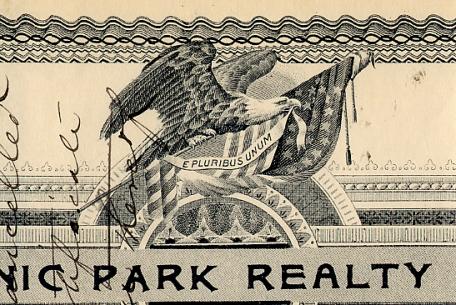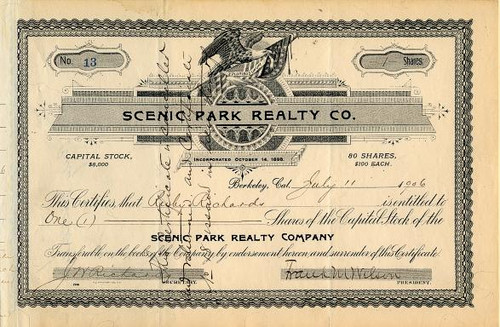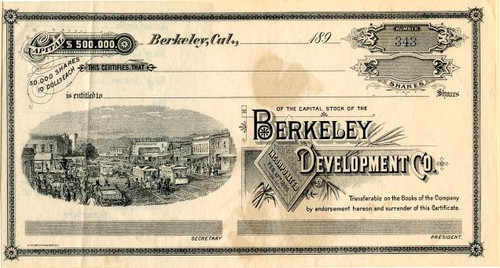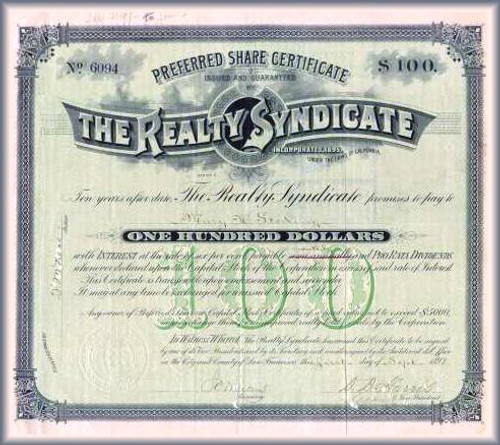Beautiful certificate from the Scenic Park Realty Co issued in 1906. This historic document was printed by H.S. Crocker Company and has an ornate border around it with a vignette of an eagle. This item has the signatures of the Company's President, Frank M. Wilson and Secretary, J. W. Richards and is over 101 years old. The certificate was issued to Ruby Richards and signed on the back. 
Certificate Vignette Northside is the oldest residential neighborhood in the Berkeley Hills. It was subdivided in 1889 by Thomas Daley, who named it Daley's Scenic Park. Two years later, the entire tract was purchased for $4,000 in gold by banker Frank M. Wilson, who began to sell lots for houses. Frank M. Wilson, a wealthy Chicago businessman began selling lots for houses. In 1894, Wilson built his own house, a barn-like Brown Shingle designed by George Frederick Estey, at 2400 Ridge Road, on the site now occupied by the GTU Library. An early member of the Hillside Club, Wilson hosted Club meetings at his home. Wilson founded the Scenic Park Realty Company, which was incorporated in 1898. The initial development of the neighborhood, begun in the mid-1890s, was strongly influenced by the Hillside Club, formed by Northside residents to protect the hills from unsightly grading and unsuitable buildings, and taking its cue from the Arts and Crafts movement. Prominent club members included Bernard Maybeck, Charles Keeler, Benjamin Ide Wheeler, and John Galen Howard. The cradle of the architectural style known as the First Bay Region Tradition, Daley's Scenic Park lost hundreds of homes in the September 17, 1923, Berkeley Fire. The fire survivors are concentrated in a triangle along the southeastern slopes of the tract, where one can find houses designed by Maybeck, Julia Morgan, Ernest Coxhead, and A.C. Schweinfurth -- influential architects of this movement, which spawned the Berkeley Brown Shingle. The houses burned in 1923 were typically replaced with stucco apartment buildings. Following the 1923 fire, seminaries purchased cheap land on Holy Hill. In the 1960s, they formed the Graduate Theological Union. The GTU library, which opened in the 1980s, is sited on land that had been occupied for over 80 years by Frank M. Wilson's home. Across the street, at 1820 Scenic Ave., is the former home of Benjamin Ide Wheeler, president of the University from 1899 to 1919. Nearby stand the University's former reception hall, built by University Regent Phoebe Apperson Hearst at 1816 Scenic Avenue, and Mrs. Hearst's own house at 2368 Le Conte Avenue. Northside was home to dozens of fraternities and sororities until the 1960s, when the University encouraged them to move to the Southside. Some of the chapter houses were taken over by seminaries, several were acquired by the University Students' Cooperative Association, and many others were razed to make way for University facilities such as the two Hearst parking structures, Etcheverry Hall (1966), Foothill Student Housing (1990), and Soda Hall (1994). History from Wikipedia and OldCompanyResearch.com (old stock certificate research service).

Certificate Vignette














